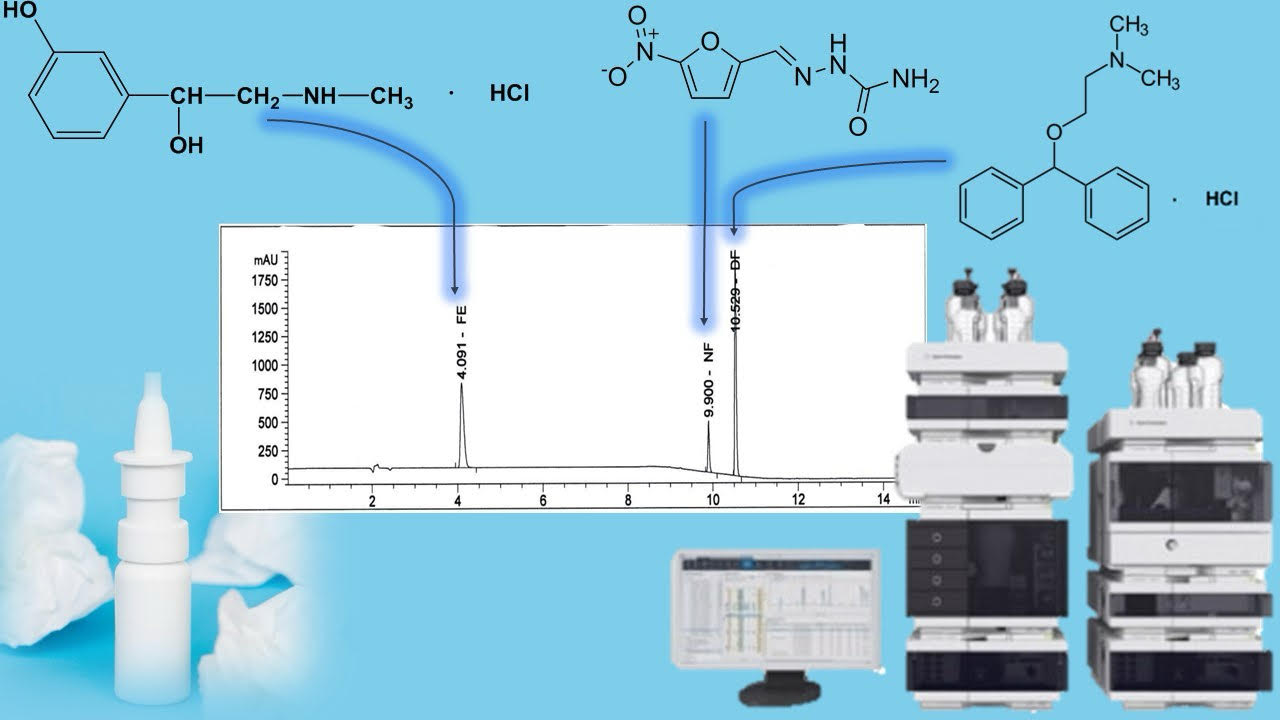Розробка та валідація аналітичної методики кількісного визначення діючих речовин у екстемпоральному комбінованому лікарському засобі у формі спрею
DOI:
https://doi.org/10.15587/2519-4852.2023.294919Ключові слова:
спрей, фенілефрину гідрохлорид, нітрофурал, дифенгідраміну гідрохлорид, кількісне визначення, рідинна хроматографіяАнотація
Метою роботи є розробка і вивчення валідаційних характеристик методики кількісного визначення фенілефрину гідрохлориду, нітрофуралу та дифенгідраміну гідрохлориду при сумісній присутності в екстемпоральному комбінованому лікарському засобі у формі спрею методом рідинної хроматографії.
Матеріали і методи. Рідинні хроматографи Agilent 1260, обладнані діодно-матричним та УФ-детектором фірми «Agilent technologies», США. Колонки хроматографічні розміром 250×4,6 мм, що заповнена силікагелем октадецилсилільним для хроматографії (Zorbax StableBond SB-Aq, фірми «Agilent»), рухома фаза – 0,1 % водний розчин трифтороцтової кислоти Р – метанол Р, режим елюювання – градієнтний; швидкість рухомої фази – 1,2 мл/хв; довжина хвилі детектування – 220 нм.
Результати. Визначені умови хроматографування забезпечують належне розділення піків визначуваних речовин: фенілефрину гідрохлориду, нітрофуралу та дифенгідраміну гідрохлориду у спільній присутності, та не чинять негативного впливу на кількісну оцінку їх вмісту. Для підтвердження придатності аналітичної методики для виконання поставленої задачі – контролю кількісного вмісту діючих речовин у комбінованому лікарському засобі у формі спрею – було проведено валідаційні випробування. Визначені валідаційні характеристики свідчать про те, що методика характеризується належною специфічністю, лінійністю, правильністю та збіжністю в діапазоні застосування для фенілефрину гідрохлориду (діапазон 0.499-0.749 мг/мл, ΔZ=0.44 ≤ max ΔZ=3.20, d=0.22 ≤ max d=1.02, a=0.01 max a=5.1, r = 0.9997 min r= 0.9924), нітрофуралу (діапазон 0.154-0.231 мг/мл, ΔZ=0.44 ≤ max ΔZ=3.20, d=0.62 ≤ max d=1.02, a=0.0006 max a=5.1, r = 0.9996 min r= 0.9924) та дифенгідраміну гідрохлориду (діапазон 0.499-0.749 мг/мл, ΔZ=0.50 ≤ max ΔZ=3.20, d=0.05 ≤ max d=1.02, a=0.076 max a=5.1, r = 0.9999 min r= 0.9924).
Висновки. Розроблено аналітичну методику кількісного визначення фенілефрину гідрохлориду, нітрофуралу та дифенгідраміну гідрохлориду при сумісній присутності у екстемпоральному комбінованому лікарському засобі у формі спрею методом високоефективної рідинної хроматографії. Визначені валідаційні параметри підтверджують коректність методики. Запропонована методика ВЕРХ використана для вивчення хімічної стабільності спрею для лікування алергічного риніту
Посилання
- Polovko, N. P. , Zuykina, E. V. (2018). Condition of the extemporal formulation in Ukraine and the problems of the present. Coliection of scientific works of staff member of Shupyk NHU of Ukraine, 32, 294–307.
- Savchenko, L. P., Heorhiiants, V. A. (2020). Vyhotovlennia likiv u aptekakh: indyvidualnyi pidkhid iz vikovymy tradytsiiamy. Zdorovia Ukrainy 21 storichchia, 11 (480).
- Sulistiyo, J. (2023). Assay of Diphenhydramine HCl in Syrup by High Performance Liquid Chromatography. Journal of Drug Delivery and Therapeutics, 13 (6), 141–144. doi: http://doi.org/10.22270/jddt.v13i6.5885
- Al-Salman, H. N. K., Alassadi, E. A. S., Fayadh, R. H., Hussein, H. H., Jasim, E. Q. (2020). Development of The Stable, Reliable, Fast and Simple RP-HPLC Analytical Method for Quantifying Diphenhydramine-Hcl (DPH) In Pharmaceuticals. International Journal of Pharmaceutical Research, 12 (4), 4457–4467. doi: http://doi.org/10.31838/ijpr/2020.12.04.608
- Mamina, О., Kabachny, V., Tomarovska, T., Bondarenko, N. (2020). Determination of diphenhydramine by HPLC method in biological liquids. ScienceRise: Pharmaceutical Science, 4 (26), 18–24. doi: http://doi.org/10.15587/2519-4852.2020.210728
- British Pharmacopoeia 2023rd ed. (2023). The British Pharmacopoeia Secretariat. London. Available at: https://www.pharmacopoeia.com/
- Wang, K., Kou, Y., Wang, M., Ma, X., Wang, J. (2020). Determination of Nitrofuran Metabolites in Fish by Ultraperformance Liquid Chromatography-Photodiode Array Detection with Thermostatic Ultrasound-Assisted Derivatization. ACS Omega, 5 (30), 18887–18893. doi: http://doi.org/10.1021/acsomega.0c02068
- Nagarjuna, P., Tharun Kumar, B., Nalluri, B. N. (2020). Simultaneous Analysis of Phenylephrine HCl and Ketorolac Tromethamine in Bulk and Injectable Formulations by RP-HPLC-PDA Method. Journal of Drug Delivery and Therapeutics, 10 (4-s), 39–45. doi: http://doi.org/10.22270/jddt.v10i4-s.4204
- Dewani, A. P., Patra, S. (2015). A single HPLC-DAD method for simultaneous analysis of paracetamol, phenylephrine, caffeine and levocetirizine in bulk powder and tablet formulation: application to invitro dissolution studies. Journal of the Chilean Chemical Society, 60 (4), 2736–2739. doi: http://doi.org/10.4067/s0717-97072015000400019
- Bachute, M. T., Shanbhag, S. V., Turwale, S. L. (2021). Simultaneous determination of four active pharmaceuticals in tablet dosage form by reversed-phase high performance liquid chromatography. Tropical Journal of Pharmaceutical Research, 18 (10), 2161–2166. doi: http://doi.org/10.4314/tjpr.v18i10.23
- Shaalan, R. A., Belal, T. S. (2010). HPLC-DAD Stability Indicating Determination of Nitrofurazone and Lidocaine Hydrochloride in Their Combined Topical Dosage Form. Journal of Chromatographic Science, 48 (8), 647–653. doi: http://doi.org/10.1093/chromsci/48.8.647
- KNOWLEDGE Database. Available at: https://www.edqm.eu/en/knowledge-database Last accessed: 27.05.2023
- Diphenhydramine hydrochloride. 01/2016:0023, Ph.Eur. 11.0 (2016). Available at: https://pheur.edqm.eu/home Last accessed: 27.05.2023
- Diphenhydramine hydrochloride capsules, USP43. Available at: https://www.uspnf.com/ Last accessed: 27.05.2023
- Diphenhydramine hydrochloride oral solution, USP43. Available at: https://www.uspnf.com/ Last accessed: 27.05.2023
- Nitrofural, 01/2022:1135, Ph.Eur., 11.0. Available at: https://pheur.edqm.eu/home Last accessed: 27.05.2023
- Phenylephrine hydrochloride, USP43. Available at: https://www.uspnf.com/ Last accessed: 21.05.2023
- Derzhavna farmakopeia Ukrainy. Dopovnennia 4 (2.4) (2020). Kharkiv: Derzhavne pidpryiemstvo «Ukrainskyi naukovyi farmakopeinyi tsentr yakosti likarskykh zasobiv», 600.
- Derzhavna Farmakopeia Ukrainy. Vol. 1. Kharkiv: Derzhavne pidpryiemstvo «Ukrainskyi naukovyi farmakopeinyi tsentr yakosti likarskykh zasobiv», 1028.
- ICH guideline Q2(R2) on validation of analytical procedures Step 2b (2022). European Medicines Agency, 39.
- ICH Q1A (R2) Stability testing of new drug substances and drug products Step 5 (2003). European Medicines Agency, 20.
- ST-N MOZU 42-3.3:2004 Likarski zasoby. Nastanova z yakosti. Vyprobuvannia stabilnosti (2012). Kyiv: Ministerstvo okhorony zdorovia Ukrainy. Available at: https://compendium.com.ua/uk/clinical-guidelines-uk/standartizatsiya-farmatsevtichnoyi-produktsiyi-tom-1/st-n-mozu-42-3-3-2004/
- ICH guideline Q8 (R2) on pharmaceutical development Step 5 (2017). European Medicines Agency, 24.
- ICH guideline Q14 on analytical procedure development Step 2b (2022). European Medicines Agency, 65.

##submission.downloads##
Опубліковано
Як цитувати
Номер
Розділ
Ліцензія
Авторське право (c) 2023 Valeriia Cherniakova, Artem Myhal, Vitalii Rudiuk, Yaroslav Studenyak, Oleksandr Kryvanych, Nataliia Bevz, Victoriya Georgiyants

Ця робота ліцензується відповідно до Creative Commons Attribution 4.0 International License.
Наше видання використовує положення про авторські права Creative Commons CC BY для журналів відкритого доступу.








